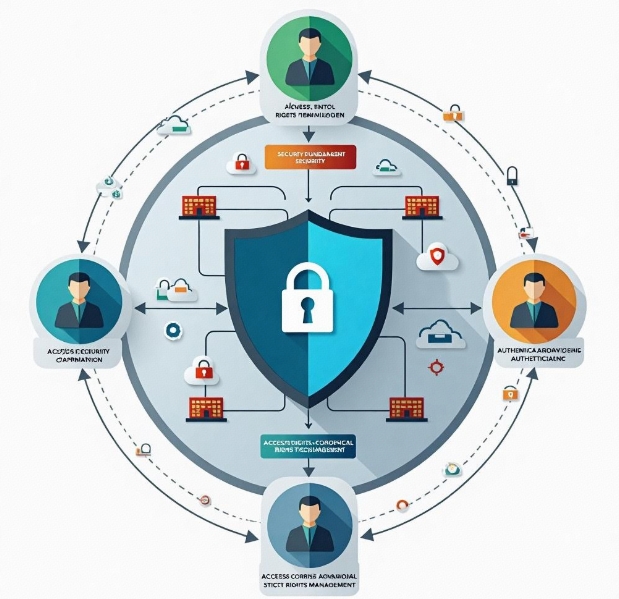How does cloud computing ensure enterprise data security and privacy protection?
- latest articles
- 1.DApp Development & Customization: Merging Diverse Market Needs with User Experience 2.Analysis of the Core Technical System in DApp Project Development 3.How to achieve cross-chain interoperability in Web3 projects? 4.How does the tokenization of points reconstruct the e-commerce ecosystem? 5.How to Set and Track Data Metrics for a Points Mall? 6.What is DApp Development? Core Concepts and Technical Analysis 7.Inventory of commonly used Web3 development tools and usage tips 8.Development of a Distribution System Integrated with Social E-commerce 9.Six Key Steps for Businesses to Build a Points Mall System 10.What is DApp Development? A Comprehensive Guide from Concept to Implementation
- Popular Articles
- 1.Future Trends and Technology Predictions for APP Development in 2025 2.Analysis of the DeFi Ecosystem: How Developers Can Participate in Decentralized Finance Innovation 3.From Zero to One: How PI Mall Revolutionizes the Traditional E-commerce Model 4.DAPP Development | Best Practices for Professional Customization and Rapid Launch 5.Recommended by the Web3 developer community: the most noteworthy forums and resources 6.From Cloud Computing to Computing Power Leasing: Building a Flexible and Scalable Computing Resource Platform 7.How to Develop a Successful Douyin Mini Program: Technical Architecture and Best Practices 8.Shared Bike System APP: The Convenient Choice in the Era of Smart Travel 9.How to Create a Successful Dating App: From Needs Analysis to User Experience Design 10.From Design to Development: The Complete Process of Bringing an APP Idea to Life
In the modern business environment, the security and privacy protection of data have become particularly important for enterprises. With the advancement of digital transformation, more and more companies are migrating their operations to cloud computing platforms to enhance business flexibility, reduce costs, and improve competitiveness. However, the widespread adoption of cloud computing also brings challenges in data security and privacy protection. This article will explore how cloud computing plays a crucial role in safeguarding data security and privacy.
I. The Relationship Between Cloud Computing and Data Security
Cloud computing is an internet-based computing model that allows enterprises to access computing resources (such as storage and processing power) on-demand over the network without owning or maintaining physical hardware. This model offers great convenience to businesses but also introduces new security threats. When enterprises store sensitive data in the cloud, ensuring that the data is not illegally accessed, tampered with, or lost becomes an issue that cannot be overlooked.
Cloud computing providers typically implement various technical and management measures to ensure data security. First, cloud service providers protect enterprise data through multi-layered security systems, such as data encryption, identity authentication, and access control. Second, cloud platforms can also provide high availability and disaster recovery mechanisms to ensure data is not lost in the event of hardware failures or natural disasters.
II. Data Encryption Technologies in Cloud Computing
Data encryption is one of the most commonly used methods for protecting data security in cloud computing. Through encryption technology, enterprises can ensure that even if data is intercepted during transmission, unauthorized parties cannot decipher its content. Data encryption primarily includes two forms: transport layer encryption and storage layer encryption.
Transport Layer Encryption: Data transmission in cloud computing is typically encrypted using secure transport protocols (such as SSL/TLS) to ensure that data is not eavesdropped on or tampered with during transmission from local systems to the cloud platform.
Storage Layer Encryption: Cloud service providers often offer storage encryption features, encrypting data when it is stored in the cloud. Even if hackers successfully breach the cloud platform, they cannot read the encrypted data. Enterprises can also choose to manage encryption keys themselves to enhance data privacy.
III. Access Control and Identity Authentication
To protect data security, cloud computing platforms are typically equipped with strict access control and identity authentication mechanisms. Through identity authentication, the cloud platform ensures that only authorized users can access enterprise data. Common identity authentication methods include:
Multi-Factor Authentication (MFA): In addition to traditional usernames and passwords, enterprises can enable multi-factor authentication mechanisms (such as SMS verification codes, fingerprint authentication, etc.) to further enhance security. Even if attackers obtain a user's password, without the second authentication factor, they still cannot access the data.
Role-Based Access Control (RBAC): Cloud platforms support role-based access control. Enterprises can assign different access permissions to different employees or users, ensuring that only those who need to access certain data can view or modify it. This fine-grained permission management significantly reduces the risk of data leakage.
IV. Data Backup and Disaster Recovery in Cloud Computing
Once enterprise data is lost, it can lead to significant economic losses and reputational damage. Therefore, data backup and disaster recovery are critical components of cloud computing. Cloud service providers typically offer regular backups, redundant data storage, and disaster recovery solutions to ensure rapid recovery in the event of data loss or system failure.
Redundant Data Storage: Cloud platforms store data copies in multiple geographic locations, ensuring that if one data center fails, copies from other data centers can immediately take over, ensuring continuous data availability.
Automatic Backup and Recovery: Enterprises can set up regular automatic backups to ensure they always have the latest data backups. If data is corrupted or lost, it can be quickly restored through the disaster recovery system, minimizing business interruption time.
V. Cloud Computing and Privacy Protection
Privacy protection is another critical security issue, especially when enterprises handle large amounts of personal data. To protect user privacy, cloud computing platforms must adhere to strict privacy protection regulations, such as the European General Data Protection Regulation (GDPR) and the U.S. Health Insurance Portability and Accountability Act (HIPAA).
Data Masking: When processing personal data, enterprises can use data masking techniques to anonymize or encrypt sensitive information, reducing the risk of data leakage. For example, user names and contact information stored in databases can be masked to prevent direct identification of individuals.
Compliance Audits: Cloud service providers need to conduct regular compliance audits to ensure their services meet global privacy protection requirements. Enterprises should choose cloud service providers that comply with these standards to ensure the compliance of their data processing processes.
VI. Security Compliance and Certification in Cloud Computing
Cloud service providers must comply with multiple security certifications and standards to ensure their platforms meet global data protection and privacy regulations. For example, common security certifications for cloud platforms include ISO 27001, SOC 2, and PCI DSS. These certifications ensure that the systems and processes of cloud service providers effectively safeguard data security and privacy.
Additionally, when selecting a cloud service provider, enterprises should verify whether it possesses compliance certifications to ensure the platform meets industry security standards. By choosing a cloud service provider with strong security compliance, enterprises can reduce the risks associated with security vulnerabilities.
VII. Security Challenges and Countermeasures in Cloud Computing
Although cloud computing offers many technical measures to ensure data security and privacy protection, it also presents certain challenges. Below are some security risks that enterprises may face in cloud computing and corresponding strategies to address them.
Shared Responsibility Model: Cloud computing adopts a shared responsibility model, where the cloud service provider is responsible for the security of the cloud platform, while the enterprise is responsible for the security of the data in the cloud. Enterprises need to clearly understand their scope of responsibility and take appropriate measures, such as encryption and access control.
Internal Threats: In addition to external attackers, internal personnel can also be a source of data leakage. To address this, enterprises should strengthen internal security training and use monitoring tools to detect abnormal behavior, preventing internal personnel from misusing their permissions.
Compliance Risks: As privacy protection regulations continue to evolve globally, enterprises need to pay special attention to compliance issues when transferring and storing data across borders. Enterprises should work closely with cloud service providers to ensure their data processing complies with relevant legal and regulatory requirements.
VIII. Summary
Cloud computing provides enterprises with efficient, flexible, and scalable data storage and processing capabilities, but it also comes with certain security and privacy protection challenges. By adopting multiple technical measures such as data encryption, access control, backup and recovery, privacy protection, and compliance audits, enterprises can safeguard data security and privacy on cloud computing platforms. As cloud computing technology continues to develop and security mechanisms improve, enterprises can more confidently utilize cloud computing services to drive digital transformation and achieve their business goals.
-

Applications and Challenges of Cloud Computing in the Internet of Things (IoT)
With the continuous advancement of information technology, cloud computing and t···
-

Integration of Cloud Computing and Artificial Intelligence: Enhancing Intelligent Applications
With the rapid advancement of technology, cloud computing and artificial intelli···
-

Data Security and Privacy Protection in Cloud Computing Applications
With the continuous advancement of information technology and the rapid developm···

 Blockchain
Blockchain












